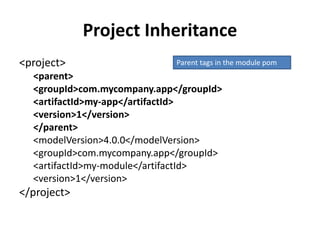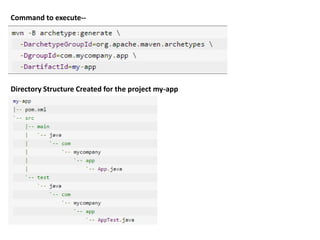Maven Basics - Explained
- 1. Maven Prepared By : Smita Prasad
- 2. Topics to be covered • What is Maven and its setup • POM • Relationships • Creating a project • Execution Groups • Mvn command • Built-in Lifecycles • Build Settings • Dependency Management
- 3. Common Problems and Activities • Multiple Jars • Jar have Dependencies and versions • Project Structure • Building , Publishing and Deploying
- 4. What is Maven? • Maven, is a Yiddish word meaning “Accumulator Of Knowledge” • It is a Plugin Execution Framework • Used for software lifecycle management • Provides a cohesive suite of plugins for • verification, • compilation, • testing, • packaging, • reporting, • and deployment.
- 5. Interoperability and Extensibility • It offers easy-to-write custom build- supplementing plugins • Reuses any desired aspect of Ant • Can compile native C, C++, and .NET code • Strong support for Java and JVM languages and platforms, such as Scala, JRuby, Groovy and Grails. • For PHP users there is a separate project by Apache called PHP-Maven.
- 6. History Maven began its life in the Jakarta Alexandria project. The Alexandria project is now defunct. It was only part of this for 5 months.
- 8. Installing Apache Maven • Extract the archive and adding the bin folder with the mvn command to the PATH. • Detailed steps are: – Ensure JAVA_HOME environment variable is set and points to your JDK installation – Setup M2_HOME to a directory under the windows user directory with a folder called .m2 – Extract distribution archive in any directory – unzip apache-maven-3.3.3-bin.zip – Add the bin directory of the created directory apache-maven-3.3.3 to the PATH environment variable – Confirm with mvn -v in a new shell. The result should look similar to set M2_HOME=c:maven-3.2.x-SNAPSHOT set PATH=%M2_HOME%bin;%PATH%
- 9. POM • POM stands for "Project Object Model“ • XML representation of a Maven project held in a file named pom.xml
- 10. Artifact Vector • Each Maven project produces an element, such as a JAR, WAR or EAR, uniquely identified by a composite of fields known as groupId, artifactId, packaging, version and scope. • This vector of fields uniquely distinguishes a Maven artifact from all others. • Many Maven reports and plugins print the details of a specific artifact in this colon separated fashion: groupid:artifactid:packaging:version:scope • An example of this output for the core Spring JAR would be: org.springframework:spring:jar:2.5.6:compile
- 11. Maven Coordinates • groupId: This is generally unique amongst an organization or a project. When stored within a repository, the group acts much like the Java packaging structure does in an operating system. The dots are replaced by OS specific directory separators (such as '/' in Unix) which becomes a relative directory structure from the base repository. – Example: The org.codehaus.mojo group lives within the directory $M2_REPO/org/codehaus/mojo. • artifactId: Name that the project is known by. – Example: my-project lives in $M2_REPO/org/codehaus/mojo/my-project. • packaging: Project’s artifact type. Default value is jar. The current core packaging values are: pom, jar, maven-plugin, ejb, war, ear, rar, par. These define the default list of goals which execute to each corresponding build lifecycle stage for a particular package structure. • version: Code changes, those changes should be versioned, and this element keeps those versions in line. It is also used within an artifact's repository to separate versions from each other. – Example: my-project version 1.0 files live in the directory structure $M2_REPO/org/codehaus/mojo/my-project/1.0.
- 12. POM Relationships • Super POM • Inheritance • Aggregation • Properties • Dependencies
- 13. Super POM Super POM POM1 POM2 POM3 • The Super POM is Maven's default POM. • It is Pseudo-invisible. • All projects inherit it. • Specifies file location defaults. • Locks version of common plugins.
- 16. Providing a uniform build system Project 1 Project 5 Project 2 Project 3 Project 4 POM & Plugins MAVEN
- 17. Project Aggregation • Instead of specifying the parent POM from the module, it specifies the modules from the parent POM <project> <modelVersion>4.0.0</modelVersion> <groupId>com.mycompany.app</groupId> <artifactId>my-app</artifactId> <version>1</version> <packaging>pom</packaging> <modules> <module>my-module</module> </modules> </project>
- 18. Inheritance Aggregation When several Maven projects have similar configurations -- refactor your projects by pulling out those similar configurations and making a parent project. When a group of projects that are built or processed together -- Create a parent project and have that parent project declare those projects as its modules. Let your Maven projects inherit that parent project, and those configurations would then be applied to all of them. Just build the parent and the rest will follow. You can have both Project Inheritance and Project Aggregation at the same time. You'd just have to apply all three rules: • Specify in every child POM who their parent POM is. • Change the parent POMs packaging to the value "pom" . • Specify in the parent POM the directories of its modules (children POMs)
- 19. Properties • One of the practices that Maven encourages is don't repeat yourself. • Maven allows you to use both your own and pre-defined variables in the POM. They come in 5 different styles— 1) ${ env.X} ${ env.PATH} 2) ${ java.X} ${ java.HOME} 3) ${ project.X} ${ project.version} 4) ${ system.X} ${ system.offline} 5) ${X} ${ someVar}
- 20. Creating a Project via Archetype • $ mvn archetype:generate • Archetype is a Maven project templating toolkit. • An archetype is defined as – an original pattern or model from which all other things of the same kind are made. • You can choose from various templates available. • You can also create your own archetype template.
- 22. Command to execute-- Directory Structure Created for the project my-app
- 23. Pom file generated via archetype
- 24. EXECUTION GROUPS • Maven divides execution into four nested hierarchies. • From most-encompassing to most- specific, • They are: Lifecycles, Phases, Plugins and Goals • Lifecycle - Flow of steps • Phase - A step in a lifecycle • Plugin – Logical grouping and distribution of related goals • Goal - Single executable task
- 25. THE MVN COMMAND • Maven supplies a Unix shell script and MSDOS batch file named mvn and mvn.bat respectively. • This command is used to start all Maven builds. • Optional parameters are supplied in a space- delimited fashion. mvn clean package jetty:run –Dmaven.test.skip
- 26. Executing a Phase or Goal • At the command prompt, either a phase or a plugin goal can be requested. • Multiple phases or goals can be specified and are separated by spaces. • Example - mvn compile:compile jar:jar • If you execute a phase, all phases and bound plugin goals up to that point in the lifecycle are also executed. • Example - mvn deploy This example requests the deploy lifecycle phase, which will also execute the verification, compilation, testing and packaging phases.
- 27. Built-in Maven Lifecycles • Maven ships with three lifecycles; clean, default, and site. • The clean lifecycle is simplistic in nature. It deletes all generated and compiled artifacts in the output directory.
- 28. • The default lifecycle defines the most commonly used phases for building an application, ranging from compilation of the code to installation of the completed artifacts, such as a JAR, into a remote Maven repository.
- 30. • The site lifecycle generates a project information web site, and can deploy the artifacts to a specified web server or local path.
- 31. Build Settings • defaultGoal: the default goal or phase to execute if none is given. • directory: This is the directory where the build will dump its files. • finalName: This is the name of the bundled project when it is finally built.It defaults to ${artifactId}-${version}. • filter: Defines *.properties files that contain a list of properties that apply to resources on build.
- 32. Resources • Specify where the resource files will be placed in the artifact.
- 33. Add Resources to JAR Just place the files in the “resources ” folder It is added in JAR under META-INF folder
- 34. Filter Resources • A resource file may need to contain a value that can only be supplied at build time. • To accomplish this in Maven, put a reference to the property that will contain the value into your resource file using the syntax – ${<property name>} • The property can be one of the values defined in – your pom.xml, – a value defined in the user's settings.xml, – a property defined in an external properties file, – or a system property.
- 37. Using External Properties File application.name=${pom.name} application.version=${pom.version} message=${my.filter.value} In application.properties my.filter.value=hello! In filter.properties In pom.xml
- 38. DEPENDENCIES • To express your project’s reliance on a particular artifact, you declare a dependency in the project’s pom.xml.
- 40. Transitive Dependencies Discovery Feature Description Dependency mediation Determines what version of a dependency is to be used when multiple versions of an artifact are encountered. If two dependency versions are at the same depth in the dependency tree, the first declared dependency will be used. Dependency management Directly specify the versions of artifacts to be used when they are encountered in transitive dependencies. For an example project C can include B as a dependency in its dependencyManagement section and directly control which version of B is to be used when it is ever referenced. Dependency scope Includes dependencies as per the current stage of the build Excluded dependencies Any transitive dependency can be excluede using "exclusion" element. As example, A depends upon B and B depends upon C then A can mark C as excluded. Optional dependencies Any transitive dependency can be marked as optional using "optional" element. As example, A depends upon B and B depends upon C. Now B marked C as optional. Then A will not use C.
- 42. • Used to pull all the dependency information into a common POM file, simplifying the references in the child POM file. • Used when you have multiple attributes that you don’t want to retype in under multiple children projects. • Used to define a standard version of an artifact to use across multiple projects.
- 43. VISUALIZE Dependencies • List view ‣ mvn dependency:resolve • Tree view ‣ mvn dependency:tree • Plugin list view ‣ mvn dependency:resolve-plugins
- 44. Standard Scopes • Each dependency can specify a scope, which controls its visibility and inclusion in the final packaged artifact, such as a WAR or EAR. • Scoping enables you to minimize the JARs that ship with your product.
- 45. Exclusion
- 46. Thanks














































